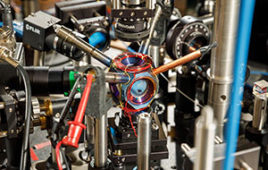Researchers at Drexel University in Philadelphia are working on flexible and wearable energy storage using smart and electronic textiles. Rather than clip a bulky battery to one’s clothing, the researchers are developing technology that can be woven into regular clothing, using carbon atoms integrated into yarn.
 The research team includes people from AJ Drexel Nanotechnology Institute and those working with Professor Genevieve Dion at the university’s Shima Seiki Haute Tech Lab.
The research team includes people from AJ Drexel Nanotechnology Institute and those working with Professor Genevieve Dion at the university’s Shima Seiki Haute Tech Lab.
The researchers are developing unique yarn-electrodes for wearable supercapacitors, which they say can be knitted into full textiles and garments. Commercial available yarns made of cellulose — materials such as cotton, linen, bamboo, viscose, or rayon — can be used, and they are strong enough to be knitted into fabric without breaking in the process.
Using a process called “Natural Fiber Welding,” they treat the yarn with a molten salt to get the polymer chains to swell, which causes the structure to open. Then functional material such as activated carbon particles is embedded inside by sliding the yarn through a syringe filled with a mixture of the material in the ionic liquid. Then the yarn gets pulled through the needle of the syringe, physically pressing the carbon into the fibers, and then it’s wound around a spool. In order to take away the ionic liquid and re-solidify the cotton fiber and trap carbon particles in the surface, the yarn gets washed with water. The resulting material is complex and fibrous — it keeps its original flexibility but now has activated carbon’s capacitive properties.
Similar work is being done at Case Western Reserve University in Cleveland, Ohio, where scientists (in collaboration with researchers at Nanyang Technological University in Singapore and Tsinghua University in China) are working on a fiber-like energy storage device that could be woven into clothing and power wearable medical monitors, communications equipment, or other small electronic devices. The resulting supercapacitor utilizes an interconnected, tight network of graphene and carbon nanotubes that can be compared to some thin-film lithium batteries in terms of energy storage capabilities. The researchers say that the volumetric energy density (storage capacity by volume) is “the highest reported for carbon-based microscale supercapacitors to date: 6.3 microwatt hours per cubic millimeter.” Additionally, the device is able to charge and release energy at a faster rate than a battery.
In addition to textiles, Stanford University researchers are exploring paper as a source for supercapacitors. The fibers in both paper and textiles are coated with with nanoscale conductive materials in order to transform them into high-performance supercapacitors for the electric grid. Paper and textiles’ rough surfaces are suitable for these energy devices since things like supercapacitors and lithium ion batteries prefer large-surface roughness. This research could result in an eco-friendly form of energy storage technology. Additionally, paper and textiles are low-cost materials, which make them an appealing alternative to more expensive batteries.
More information:
Drexel University
Case Western Reserve University
Stanford University




